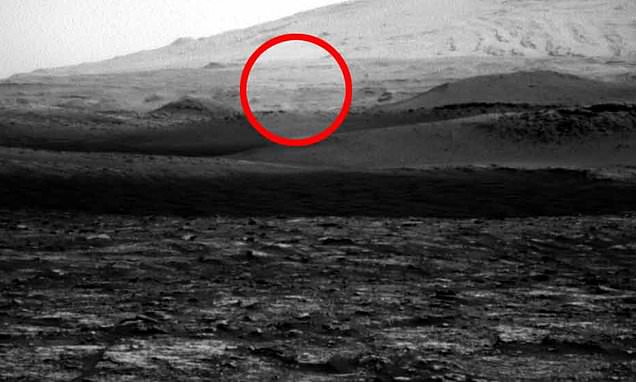
Humanity’s Quiet Symphony on Mars: Curiosity Rover Captured in Motion by NASA Orbiter
In a groundbreaking moment for Martian exploration, NASA has obtained a stunning image that beautifully showcases both the sophistication of space technology and the marvels of interplanetary science. On February 28, 2024, the HiRISE (High Resolution Imaging Science Experiment) camera aboard NASA’s Mars Reconnaissance Orbiter (MRO) recorded a momentous photograph of the Curiosity rover as it moved across the challenging terrain of the Red Planet.
A Unique View Across Space and Time
In the captivating image, the Curiosity rover is depicted as a tiny dark spot against the broad rust-hued landscape of Mars’ Gale Crater. However, a closer look reveals much more—a trail of fresh, meandering tracks extending over 1,050 feet behind the rover. This unusual collaboration between two innovative spacecraft, one exploring on the ground and the other in orbit, effectively illustrates NASA’s ability to orchestrate complex, multi-faceted missions millions of miles away from Earth.
“This is one of those snapshots that reminds you you’re witnessing history unfold,” remarked Doug Ellison, an integral member of Curiosity’s planning group at NASA’s Jet Propulsion Laboratory (JPL). “By synchronizing the timing of HiRISE’s capture with Curiosity’s daily operational logs, we established that the rover had nearly completed a 69-foot drive at the moment the image was taken.”
Curiosity’s Intentional Expedition
Landing on Mars in 2012, the rover has been investigating the layered slopes of Mount Sharp—the main peak located within Gale Crater. Its ongoing path, which started on February 2, encompasses 11 meticulously coordinated drives, aimed at reaching a novel scientific target near a zone believed to contain boxwork formations. These intricate, web-like mineral structures, if verified, could indicate significant groundwater activity billions of years ago, shedding light on Mars’ ancient climate and its potential to support microbial life.
Traversing Mars: One Drive at a Time
Despite its advanced design, Curiosity navigates at a glacial pace—around 0.1 miles per hour, slower than a young child’s walk. Nevertheless, each segment of progress is purposeful and significant. Engineers at JPL work hand in hand with planetary scientists to decipher terrain characteristics via satellite imagery, chart optimal paths, and activate Curiosity’s autonomous navigation systems.
The Martian landscape consistently poses challenges, with steep inclines, loose soil, and rocky routes testing the rover’s endurance daily. At the moment the image was captured, Curiosity was on the verge of a notably steep slope, which it has since managed to climb successfully—further showcasing the engineering prowess driving Mars exploration.
The Enchantment Behind the Image
HiRISE, stationed on the Mars Reconnaissance Orbiter since 2006, remains one of the most advanced telescopic imagers dispatched to another planet. Each image it captures spans vast distances, with resolutions accurate enough to distinguish individual boulders and vehicle tracks. The camera employs multiple channels—a strip of full color down the middle and black-and-white on the edges.
Ironically, during this particular capture, Curiosity traversed the monochrome section of the scene. While it missed another chance for a full-color appearance, the contrast in the black-and-white shot still provided an exceptionally clear view of the rover in its pure state—advancing across a lifeless planet, rich with untold stories waiting to be discovered.
Symbol of Adventure and Tenacity
Curiosity’s meandering journey across Mars transcends mere data collection and rock analysis. It embodies the persistent human aspiration to explore the unknown, to push the limits of Earth, and to comprehend our cosmic beginnings. The fleeting tracks it leaves are more than simple impressions—they represent milestones in a scientific odyssey recorded one drive at a time.
“Pictures like this one do more than highlight technology,” Ellison added. “They forge an emotional connection to our distant mechanical messengers. They serve as a reminder that we’re capable of exploring planets and deciphering enigmas that predate humanity itself.”
Forward Into Martian History
Curiosity is anticipated to arrive at its next significant research site within the next month, where it will analyze rock samples and examine the uncharted terrain for evidence that water once flowed—and may have even supported primitive life—on the presently arid Martian surface.
With each rotation of its wheels, Curiosity uncovers another facet of Mars’ intricate, water-carved history. And whether viewed from above or across the desolate plains, NASA’s paired spacecraft continue to document a narrative of opportunity, determination, and planetary science.
As dust devils whirl and winds gradually erode the rover’s tracks, a deep thought endures: The human imprint—however indirect—is now indelibly marked on Martian soil.
Support Independent Science Reporting
If this article informed or motivated you, please consider making a donation. Our independent coverage brings